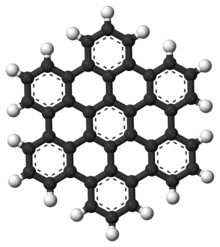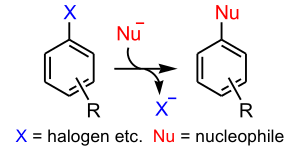Aromatic compound
This article is missing information about Non-benzenoid aromatic compounds. (October 2022) |

Aromatic compounds or arenes usually refers to organic compounds "with a chemistry typified by benzene" and "cyclically conjugated."[1] The word "aromatic" originates from the past grouping of molecules based on odor, before their general chemical properties were understood. The current definition of aromatic compounds does not have any relation to their odor. Aromatic compounds are now defined as cyclic compounds satisfying Hückel's Rule.[2] Aromatic compounds have the following general properties:
- Typically unreactive[2]
- Often non polar and hydrophobic.[2]
- High carbon-hydrogen ratio[2]
- Burn with a strong sooty yellow flame, due to high C:H ratio[2]
- Undergo electrophilic substitution reactions and nucleophilic aromatic substitutions[3]
Arenes are typically split into two categories - benzoids, that contain a benzene derivative and follow the benzene ring model, and non-benzoids that contain other aromatic cyclic derivatives.[2] Aromatic compounds are commonly used in organic synthesis and are involved in many reaction types, following both additions and removals, as well as saturation and dearomatization.
Heteroarenes
Heteroarenes are closely related aromatic compounds, where at least one methine or vinylene (-C= or -CH=CH-) group is replaced by a heteroatom: oxygen, nitrogen, or sulfur.[4] Examples of non-benzene compounds with aromatic properties are furan, a heterocyclic compound with a five-membered ring that includes a single oxygen atom, and pyridine, a heterocyclic compound with a six-membered ring containing one nitrogen atom. Hydrocarbons without an aromatic ring are called aliphatic. Approximately half of compounds known in the year 2000 are described as aromatic to some extent.[5]



Applications
Aromatic compounds are pervasive in nature and industry. Key industrial aromatic hydrocarbons are benzene, toluene, Xylene called BTX. Many biomolecules have phenyl groups including the so-called aromatic amino acids.
Benzene ring model


Benzene, C6H6, is the least complex aromatic hydrocarbon, and it was the first one defined as such.[7] Its bonding nature was first recognized independently by Joseph Loschmidt and August Kekulé in the 19th century.[7] Each carbon atom in the hexagonal cycle has four electrons to share. One electron forms a sigma bond with the hydrogen atom, and one is used in covalently bonding to each of the two neighboring carbons. This leaves six electrons, shared equally around the ring in delocalized pi molecular orbitals the size of the ring itself.[6] This represents the equivalent nature of the six carbon-carbon bonds all of bond order 1.5. This equivalency can also explained by resonance forms.[6] The electrons are visualized as floating above and below the ring, with the electromagnetic fields they generate acting to keep the ring flat.[6]
The circle symbol for aromaticity was introduced by
Benzene and derivatives of benzene

Benzene derivatives have from one to six
For example, three isomers exist for cresol because the methyl group and the hydroxyl group (both ortho para directors) can be placed next to each other (ortho), one position removed from each other (meta), or two positions removed from each other (para).[11] Given that both the methyl and hydroxyl group are ortho-para directors, the ortho and para isomers are typically favoured.[11] Xylenol has two methyl groups in addition to the hydroxyl group, and, for this structure, 6 isomers exist.[citation needed]
- Representative arene compounds
Arene rings can stabilize charges, as seen in, for example, phenol (C6H5–OH), which is
Non-benzylic arenes
Although benzylic arenes are common, non-benzylic compounds are also exceedingly important. Any compound containing a cyclic portion that conforms to Hückel's rule and is not a benzene derivative can be considered a non-benzylic aromatic compound.[6]
Monocyclic arenes
Of annulenes larger than benzene, [12]annulene and [14]annulene are weakly aromatic compounds and [18]annulene, Cyclooctadecanonaene, is aromatic, though strain within the structure causes a slight deviation from the precisely planar structure necessary for aromatic categorization.[12] Another example of a non-benzylic monocyclic arene is the cyclopropenyl (cyclopropenium cation), which satisfies Hückel's rule with an n equal to 0.[13] Note, only the cationic form of this cyclic propenyl is aromatic, given that neutrality in this compound would violate either the octet rule or Hückel's rule.[13]
Other non-benzylic monocyclic arenes include the aforementioned heteroarenes that can replace carbon atoms with other heteroatoms such as N, O or S.[6] Common examples of these are the six-membered pyrrole and five-membered pyridine, both of which have a substituted nitrogen[14]
Polycyclic aromatic hydrocarbons

Reactions
Aromatic ring systems participate in many organic reactions.
Substitution
In aromatic
An example of electrophilic aromatic substitution is the nitration of salicylic acid, where a nitro group is added para to the hydroxide substituent:

Hydrogenation
The compound
Dearomatization
In dearomatization reactions the aromaticity of the reactant is lost. In this regard, the dearomatization is related to hydrogenation. A classic approach is Birch reduction. The methodology is used in synthesis.[28]

See also
- Aromatic substituents: Arenediyl
- Asphaltene
- Hydrodealkylation
- Simple aromatic rings
- Rhodium-platinum oxide, a catalyst used to hydrogenate aromatic compounds.
References
- ^ "Aromatic". IUPAC GoldBook. Retrieved 2023-11-06.
- ^ a b c d e f "Aromatic Compounds - Definition, Example, Properties & Nomenclature with Videos". BYJUS. Retrieved 2023-11-06.
- ISBN 978-0-471-72091-1
- ^ IUPAC. Compendium of Chemical Terminology, 2nd ed. (the "Gold Book"). Compiled by A. D. McNaught and A. Wilkinson. Blackwell Scientific Publications, Oxford (1997). Online version (2019-) created by S. J. Chalk. ISBN 0-9678550-9-8. https://doi.org/10.1351/goldbook.
- PMID 15137807.
- ^ ISBN 9781119444251.
- ^ a b "Benzene | Definition, Discovery, Structure, Properties, & Uses | Britannica". www.britannica.com. Retrieved 2023-11-06.
- ISSN 0368-1645.
- ^ ISSN 0021-9584.
- ^ a b c d "16.5: An Explanation of Substituent Effects". Chemistry LibreTexts. 2015-05-03. Retrieved 2023-12-03.
- ^ a b "Cresol - an overview | ScienceDirect Topics". www.sciencedirect.com. Retrieved 2023-12-03.
- ^ "What does "aromatic" really mean?". Chemistry LibreTexts. 2013-10-02. Retrieved 2023-11-06.
- ^ a b "What does "aromatic" really mean?". Chemistry LibreTexts. 2013-10-02. Retrieved 2023-11-29.
- ^ "4.2: Covalent Bonds". Chemistry LibreTexts. 2020-07-30. Retrieved 2023-11-06.
- S2CID 97930473.
- ^ a b c "Polycyclic Aromatic Hydrocarbons – Occurrence in foods, dietary exposure and health effects" (PDF). European Commission, Scientific Committee on Food. December 4, 2002. Archived (PDF) from the original on 2022-10-09.
- ^ PMID 6352775.
- ^ Scientific Opinion of the Panel on Contaminants in the Food Chain on a request from the European Commission on Marine Biotoxins in Shellfish – Saxitoxin Group. The EFSA Journal (2009) 1019, 1-76.
- ISSN 1040-6638.
- ISSN 0045-6535.
- PMID 16805704.
- S2CID 198333072.
- ^ "22.4: Electrophilic Aromatic Substitution". Chemistry LibreTexts. 2014-11-26. Retrieved 2023-11-29.
- ^ "16.7: Nucleophilic Aromatic Substitution". Chemistry LibreTexts. 2015-05-03. Retrieved 2023-11-29.
- ISBN 978-0-19-927029-3.
- ^ Meyers, A. I.; Beverung, W. N.; Gault, R. "1-Naphthol". Organic Syntheses. 51: 103; Collected Volumes, vol. 6.
- ^ Noland, Wayland E.; Baude, Frederic J. "Ethyl Indole-2-carboxylate". Organic Syntheses. 41: 56; Collected Volumes, vol. 5.
- PMID 21506209.
- PMID 33791426.
External links
 Media related to aromatic compounds at Wikimedia Commons
Media related to aromatic compounds at Wikimedia Commons
















